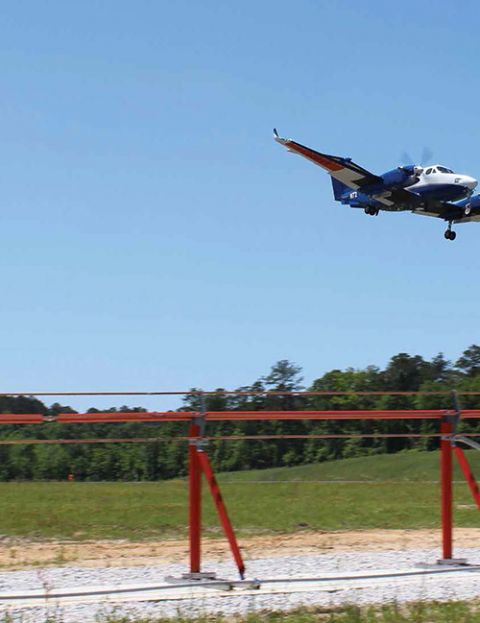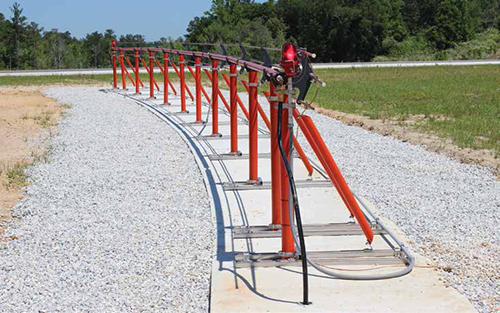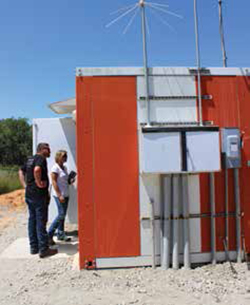Troy Municipal Overcomes Environmental & Cost Issues With Alternative Instrument Landing System Antenna

To continue supporting high levels of general aviation and military activity, Troy Municipal Airport at N. Kenneth Campbell Field (TOI) completed a bevy of requisite steps to begin the extension of its primary runway. Permits and land were acquired, the site was prepped and new pavement was installed.
And then the project got complicated.
When the Alabama airport began finalizing the last few details for its plans to lengthen Runway 7-25, officials came to the unsettling realization that the relocation of the glide slope instrument landing system (ILS) had been overlooked.
| FACTS&FIGURES Project: End-fire Glide Slope Antenna Installation for Instrument Landing System Location: Troy (AL) Municipal Airport at N. Kenneth Campbell Field Site: Runway 7-25 Involved Parties: City of Troy; U.S. Army; FAA; ALDOT Aeronautics Bureau; Goodwyn, Mills and Cawood; Watts Antenna Company Construction Cost: $875,000 (including build-out of a retaining wall, relocation of old glide slope shelter & construction of access roads) Overall Cost: Nearly $1.1 million Funding: FAA - 90%; Alabama Dept. of Transportation Aeronautics Bureau - 5%; City of Troy - 5% |
Needless to say, the project came to a halt. Not only did the airport lack the necessary land, but the specific area needed for a critical portion of the glide scope was also a wetlands habitat fraught with environmentally sensitive elements.
"We didn't have any dirt there; we just had a 50-foot void," explains Airport Manager Trent Crawford. "We didn't have the necessary land there needed to reflect the image-type ILS signals from the antenna."
Completing the ILS with a traditional image-type glide slope would have required environmental mitigation, property acquisition and major construction-not to mention significant time and cost. So TOI went back to the drawing board. In October 2012, the airport hired Goodwyn, Mills and Cawood and challenged the architectural and engineering firm to find a cost-effective solution to its glaring airfield problem.
The firm's Airport Planning and Engineering Department immediately researched FAA regulations on image glide slope systems as well as specifications for a lesser-known alternative, an end-fire glide slope.
"Most airports would never even consider, or have even heard of, those types, because they have the ground and they just put up a normal image antenna," explains Project Manager Michelle Conway. "Since we didn't have that option here, we had to look at the outside-the-box type of antenna, which is the end-fire."
Dark Horse Solution
"I had never heard of (an end-fire glide slope antenna) and I had never worked on one," Conway acknowledges, noting that all previous U.S. installations were federal projects conducted internally by the FAA. "When we got the call from Troy that it was going to cost $2 million to fill in the dirt and have an image glide slope in this location, they wanted to know if there was anything else that could be done."
 Personnel from Goodwyn, Mills and Cawood scoured multiple sources researching and analyzing alternative options for the airport's difficult situation. While doing so, they discovered that unlike image glide slopes, where the glide slope signal is bounced off the ground in front of it, end-fire glide scopes bypass the ground plane to use the antenna array itself to project signals outward. This arrangement not only provides benefits for airports like TOI with limited or environmentally sensitive land, but also in waterside installations and at sites with significant terrain issues.
Personnel from Goodwyn, Mills and Cawood scoured multiple sources researching and analyzing alternative options for the airport's difficult situation. While doing so, they discovered that unlike image glide slopes, where the glide slope signal is bounced off the ground in front of it, end-fire glide scopes bypass the ground plane to use the antenna array itself to project signals outward. This arrangement not only provides benefits for airports like TOI with limited or environmentally sensitive land, but also in waterside installations and at sites with significant terrain issues.
Goodwyn, Mills and Cawood then consulted with John H. Johnson Sr., president of Watts Antenna Company, to discuss the potential use of an end-fire glide slope for this situation. Because of its frangible tubular fiberglass design, an end-fire system can be relatively close to the runway, with the electronic equipment shelter constructed outside the runway safety area on the downslope side of the embankment.
With 60 successful installations worldwide, Johnson confirmed that the end-fire system was developed for difficult sites such as TOI.
 "Difficult meaning complex, in the manner of limited ground, limited installation area, or some complex terrain that would hinder normal, or the average landing systems, from playing," Johnson explains. The main antenna sections of the end-fire are spaced at 430 feet longitudinal and at a height of approximately 4 feet, whereas a tower type would be at a minimum 21 feet high, he adds.
"Difficult meaning complex, in the manner of limited ground, limited installation area, or some complex terrain that would hinder normal, or the average landing systems, from playing," Johnson explains. The main antenna sections of the end-fire are spaced at 430 feet longitudinal and at a height of approximately 4 feet, whereas a tower type would be at a minimum 21 feet high, he adds.
"In Troy's case, there was the displacement of the antenna from the runway centerline for runway safety and an obstacle-free zone," notes Johnson. "Their shelter is down over the side, and they didn't have a lot of lateral land mass to put a conventional image type."
Million Dollar Bargain
During planning phases, the team from Goodwyn, Mills and Cawood became increasingly aware that an end-fire system was not a typical installation-not only due to its design and physical attributes, but also because of its cost. End-fire antenna equipment is significantly more expensive than traditional image glide slope antenna equipment, with individual prices starting at $350,000. The end-fire system TOI ultimately debuted in May 2014 cost $1.1 million and proved to be a bargain compared to the overall project's $2 million construction price. (The $1.1 million antenna cost included engineering design, construction materials, sub-consultant fees, FAA flight inspections and certifications.)
 "Basically, the system [required] very minimal site preparation and saved a lot of money, and a lot of time, with a project that had already been going on for quite some time," Conway says of end-fire glide slope array now located between the taxiway and runway.
"Basically, the system [required] very minimal site preparation and saved a lot of money, and a lot of time, with a project that had already been going on for quite some time," Conway says of end-fire glide slope array now located between the taxiway and runway.
"We didn't know how it would perform until we actually got the FAA flight check out there to commission and certify the system. To date, there have been no problems with it whatsoever," he reports. "It has been a wonderful project, and it was a huge task to overcome."
In addition to overcoming all of the obstacles in play, the system at TOI is also important for another reasons observes Johnson. "It is the first time the end-fire has been installed by a private contractor to support a dual use of civilian and military operations," he explains, noting that the antenna of the ILS glide slope was installed by the U.S. Army for training purposes at Fort Rucker. "The partnership is the unique aspect."
FREE Whitepaper
PAVIX: Proven Winner for All Airport Concrete Infrastructure
International Chem-Crete Corporation (ICC) manufactures and sells PAVIX, a unique line of crystalline waterproofing products that penetrate into the surface of cured concrete to fill and seal pores and capillary voids, creating a long lasting protective zone within the concrete substrate.
Once concrete is treated, water is prevented from penetrating through this protective zone and causing associated damage, such as freeze-thaw cracking, reinforcing steel corrosion, chloride ion penetration, and ASR related cracking.
This white paper discusses how the PAVIX CCC100 technology works and its applications.








